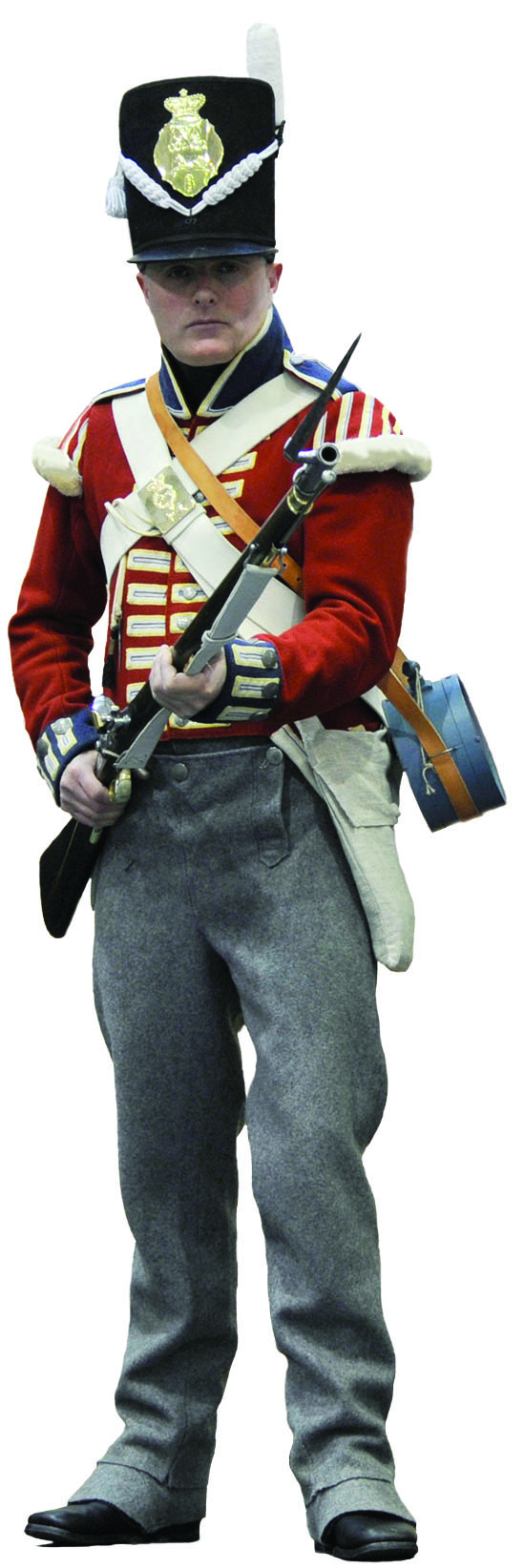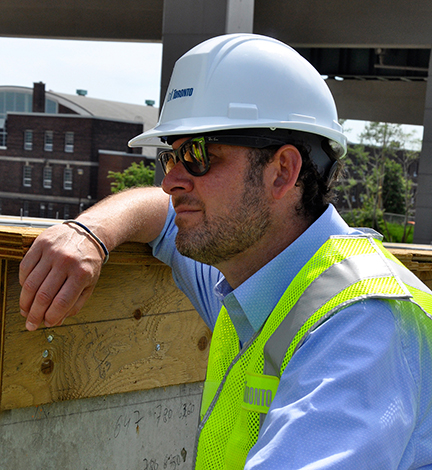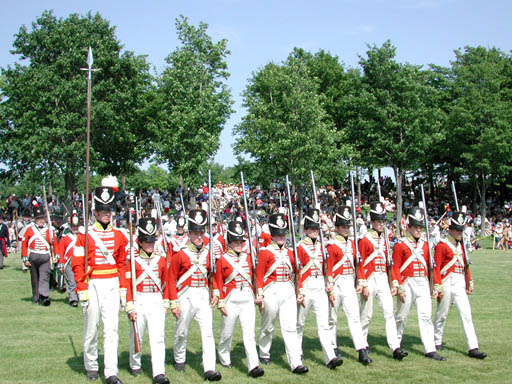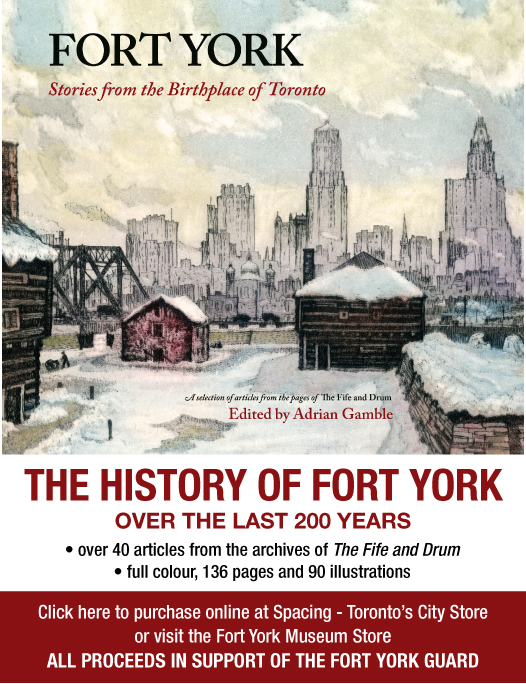Wayne Reeves retires as Chief Curator
by Andrew Stewart
Wayne joined what was then called City of Toronto Museums in 2009, providing leadership for the Collections and Conservation unit, responsible for managing Toronto’s 1.3-million-item artifact collection. He had previously led policy and research projects for Toronto Parks, Forestry Wayne Reeves, who retired on February 25, is seen here thinking hard at the Sleeping Bear Dunes National Lakeshore in Michigan on May 20, 2018. Photo courtesy Julia York
Wayne Reeves, who retired on February 25, is seen here thinking hard at the Sleeping Bear Dunes National Lakeshore in Michigan on May 20, 2018. Photo courtesy Julia York
and Recreation as a historical geographer. His specialty was the history of Toronto’s waterfront – contributing substantially to master plans for parks and development along Toronto’s ever-evolving shoreline.
He has written widely for scholarly and public readerships on topics relating to the history of Toronto. These include water infrastructure (including sewers and waste disposal – see “Burying and burning trash on Toronto’s Military Reserve” in the F&D, March 2015), brewing and, most recently, Packaged Toronto: a Collection of the City’s Historic Design, together with Spacing’s Matt Blackett and Alexandra Avdichuk, the City’s Supervisor of Collections and Conservation.
Wayne was hired just as planning for the City’s War of 1812 Bicentennial commemoration was getting underway. He directed the research and exhibit program for the bicentennial and was deeply involved in the design of exhibits unveiled in the Fort York Visitor Centre in September 2016. The building and the exhibits were never meant to dominate the National Historic Site but rather, as Brian Leigh Dunnigan writes in his review (F&D, December 2016), serve to introduce the site and the conflict at the heart of the story of the fort.
Together with David O’Hara, manager of Fort York, and his staff, and a great many other people, Wayne and his staff rose to the challenge of designing, costing and ultimately opening the Visitor Centre, one of Toronto’s great attractions, and internationally recognized for its architecture as well as its exhibits. Wayne wrote about his vision for the Vault (in the F&D, October 2010), a special room inside the Visitor Centre built to highlight prized artifacts with unique stories in the City’s collections. He then oversaw a joint effort by the Canadian Conservation Institute and the City to restore and exhibit the colours of the 3rd York Militia in the Vault (F&D, June 2013).
Together with War of 1812 Bicentennial Historian Richard Gerrard, Wayne curated Finding the Fallen: The Battle of York Remembered, which opened in the Market Gallery in 2012 (and is still on display in Fort York’s Brick Magazine) and included a book of remembrance with names of all participants in the conflict. So many commemorative events, talks, concerts, walks and exhibits during that and the following year put the fort under a favourable spotlight, setting the stage for the opening of the Visitor Centre building.
The 1812 commemoration was followed closely by that of 1914 – the commemoration of the Great War, which occupied Fort York with another intricate set of exhibits, events and programs involving public participation. These were, again, curated by Wayne and special projects coordinator Sandra Shaul. The Great War – in your Attic, Closet or Storage Locker was just one of many. The First World War touched many families in Toronto, as well as many who came here after the war, and this commemoration was deeply felt.
Wayne’s collegial nature served the interests of the fort and the community at large. He and Jane French from his staff worked closely with the Mississauga of the (then New) Credit First Nation on the exhibit Outcome of the War of 1812: First Nations Betrayed, which opened in their new community centre near Hagersville. He worked with the late Steve Otto and Michael Peters of The Friends, and the late Chris Baker, exhibition coordinator for Toronto Culture, to mount At Ease: The Military at Play in Nineteenth-Century Canada in the Blue Barracks. He generously gave his time and expertise, contributing articles and book reviews to The Fife and Drum.
He has also worked closely with fort staff and volunteers at The Friends and the Fort York Foundation in acquiring and exhibiting historic items of special affinity to the history of the fort and Toronto. These include the Cawthra family heirlooms, Upper Canada Preserved medals and Chewett’s War of 1812 regimental order book. He worked collaboratively with fort staff on two layers of interpretive panels – one inside the fort walls, the other installed as wayfinding posts across the National Historic Site, bringing an unprecedented depth and visibility to the historic interpretation of the site for visitors. These panels, beautifully designed and fabricated, have held up well over the course of a decade now.
Wayne, still a young man, and with a depth of experience, has much more to contribute. He and his wife Julia are accredited judges of craft beer and have planted heirloom varieties of apples from which they make cider. We wish him well in his future
endeavours. Exploring and writing about the history of our city we’re sure are among them.
Dr. Andrew Stewart is an award-winning archaeologist, an expert digital map-maker, and the Chair of the Fort York Foundation.
Richard Haynes turns in his musket
 Fort York site co-ordinator Richard Haynes retired in January after just over 30 years among the barracks and blockhouses of Toronto’s founding landscape. “I owe the fort (and the City) everything,” he tells the F&D, “for providing me with a great life, career and some wonderful memories.” He made a difference to the place in all kinds of ways. “His smile, wry wit and ability to call things as he saw them,” says Kevin Hebib, “always helped his colleagues.”
Fort York site co-ordinator Richard Haynes retired in January after just over 30 years among the barracks and blockhouses of Toronto’s founding landscape. “I owe the fort (and the City) everything,” he tells the F&D, “for providing me with a great life, career and some wonderful memories.” He made a difference to the place in all kinds of ways. “His smile, wry wit and ability to call things as he saw them,” says Kevin Hebib, “always helped his colleagues.”
Richard was born in Oxford, went to school in Winchester and earned his first history degree from the University College of Swansea, South Wales, in 1986. At the optimistic age of 21, he set out for Windsor, Ontario, to earn his MA. Laurie Leclair married the young scholar two years later and they sought their fortune in Toronto, where Richard was hired as an historical interpreter in August 1989.
“The fort has always been busy, sometimes crazy, but never dull,” he says, “and I’ve been lucky to work with some wonderful people over the years.” It’s hard not to regard those early days (before responsibilities grew) as the best ever, “when it was so much fun” just to come to work. There was satisfaction as well, “despite all the problems and challenges that went with the job.”
Although many celebrities, including royalty, passed through the national historic site while he was there, Richard considers the highlight of his career to have been the 200th anniversary of the Battle of York, held on the sunny weekend of April 27, 2013. Among the many events planned by the City, the Canadian Army and Fort York was Walking in Their Footsteps, the Richard as a private in the 8th (King’s) Regiment, defending muddy York.
This image appeared on posters all over the city during the Bicentennial of the battle in the spring of 2013. Courtesy 32 Canadian Brigade Group walking tour that began at dawn where the Americans landed and traced the course of the fighting back to the fort. “I will never forget looking back and seeing 700 people following me on that tour,” he marvels. “It was special and will never be repeated.”
Richard himself, of course, will never be repeated. “I have always been in awe of his steadfastness and compassion,” adds Hebib who, as a program officer at the fort, has known the man for decades. “Richard is a disciplined and measured man” who brought to his work “the thoughtfulness and focus he developed as an accomplished martial artist.”
David O’Hara also worked with Richard for most of his 15 years at the fort, a period that included management of the Invictus Games, development of the Indigenous Arts Festival and the completion of the Visitor Centre. “It was a pleasure working with Richard,” he says, “to see so many initiatives through to completion.”
In early March the Friends of Fort York (through the generosity of its chair) held a very English dinner for Richard at an old pub in the centre of the city. Conforming to the style of its subject, there were no formal speeches. The name of the place – The Queen & Beaver – might be taken as symbolic of Richard’s own career. And as a summary of those 30 years (as if we were writing the man’s obituary!) we have the words of another long-standing colleague: “There never was a kinder man.”
Kaitlin Wainwright new Site Manager
The new Manager of Fort York National Historic Site is Kaitlin Wainwright, formerly the Director of Programming at Heritage Toronto. The appointment was announced December 17 by Cheryl Blackman, Director of Museums & Heritage Services for the City.
Kaitlin first joined Heritage Toronto in 2012, where she managed the historical plaques project before becoming Director of Programming in 2014. As such, she’s had a lot to do with the agency’s new digital education projects and its Emerging Historians program. Heritage Toronto is an arms-length charitable agency that promotes and interprets the urban heritage of the city.
“The focus of her career as a public historian and cultural administrator,” said Blackman, “has been working with people to build connections between the past, present, and future, and to promote heritage as a public good.”
Kaitlin is also an avid cyclist and swimmer who knows Toronto’s waterfront well. Her position at Fort York is, strictly speaking, only interim – in the rolls of the Toronto Public Service, David O’Hara is merely “on leave” at Parks, Forestry & Recreation. We wish them both well and look forward to working closely with Kaitlin to help her advance the profile and innovative programming of Fort York National Historic Site.
An appreciation: David O’Hara’s many contributions to Fort York
by Andrew Stewart David O’Hara in early June, 2014, as the Fort York Visitor Centre nears completion. Designed by Patkau Architects of Vancouver and Kearns Mancini of Toronto, it was awarded a Governor General’s Medal in Architecture in 2018. Fort York Armoury is in the background. Photo by Kathy MillsDavid came to Fort York in 2005 with 12 years of experience as a planner and project manager in Parks & Recreation at the City of Toronto. Trained as a landscape architect and planner, he brought with him great skills and the knowledge of how work actually gets done at the City. He also brought a collegial work ethic, unrelenting energy, and an instinct for finding common ground.
David O’Hara in early June, 2014, as the Fort York Visitor Centre nears completion. Designed by Patkau Architects of Vancouver and Kearns Mancini of Toronto, it was awarded a Governor General’s Medal in Architecture in 2018. Fort York Armoury is in the background. Photo by Kathy MillsDavid came to Fort York in 2005 with 12 years of experience as a planner and project manager in Parks & Recreation at the City of Toronto. Trained as a landscape architect and planner, he brought with him great skills and the knowledge of how work actually gets done at the City. He also brought a collegial work ethic, unrelenting energy, and an instinct for finding common ground.
David had already worked with the Friends and other stakeholders on the Open Space Design and Implementation Plan for Fort York that was completed in 2001. He was familiar with what was then the fort’s unique problem: it had no surrounding neighbourhood and it was separate from the larger city. This was changing, of course, with 15,000 units then being planned and under construction. David was just the right person to meet the challenge presented by this change.
Beginning in 2005, David identified Fort York as an “archaeological landscape” encompassing 43 acres. He worked to extend oversight and protection to all its cultural resources in the context of massive neighbourhood and municipal infrastructure development. He led the charge on many fronts: elevating the profile of Fort York in Toronto as well as nationally and even internationally; consolidating the site’s physical and historic assets under the control of the Economic Development & Culture Division; giving the fort a distinctive and unifying brand; providing a front door onto Fort York Boulevard; and helping to position it as a significant destination for Torontonians and visitors alike. All of these moves were careful, strategic and cooperative.
At the start of his term, the Fort York Visitor Centre had been a beckoning (but distant) goal for decades. The approaching War of 1812 bicentennial magnified its appeal. Planning in earnest began in 2008. With enormous good will and help from Deputy Mayor Joe Pantalone, David ensured that the Visitor Centre design process met the highest standard: a professional jury was appointed to select the best design after an open competition. He consistently and persuasively argued for it to serve as a hub for the entire national historic site and for the larger, developing Fort York neighbourhood. Again, this advocacy elevated the fort’s profile, reinforcing the significance of the site as a one-of-a-kind civic common in downtown Toronto.
The city’s War of 1812 bicentennial was skillfully and passionately managed by Sandra Shaul, who worked closely with David (and many other key players, including the Canadian Army) as Fort York became the centrepiece of bicentennial events. New and talented staff combined with the deeply knowledgeable personnel already at the fort to support new programs aiming at an audience broader and more diverse than ever before. One of the bicentennial’s legacies is the annual Indigenous Arts Festival, which David was instrumental in supporting and expanding. The bicentennial also established a closer relationship with First Nations curators, historians and artists – Fort York serving as common ground.
As administrator, then manager, of the national historic site, David deftly challenged and, at the same time, made common cause with myriad departments and agencies of the City which all had a stake, one way or another, in this founding landscape. By necessity, he formed long working relationships with Planning; Parks, Forestry & Recreation; Waterfront Toronto; CreateTO; Toronto Parking Authority; the TTC; Engineering & Construction Services; and Toronto Hydro. And that’s just the City. On the federal side, the departments of Canadian Heritage and National Defence were both important to site planning, programming and management. Victoria Memorial Square came into the City’s fold, under the big wing of Parks, Forestry & Recreation, from the federal government – the last bit of land remaining from the Crown’s tenure of Garrison Common dating to the eighteenth century. A working relationship with the Department of National Defence is also important, given that the future of Fort York Armoury, part of the national historic site, remains undefined. And a strong relationship was forged with the Lieutenant Governor’s office, His Honour David Onley visiting the fort on several occasions and holding his New Year’s levee there in 2011.
In addition to all these, there were (and remain) community stakeholders, program partners, project managers (for the Visitor Centre construction and War of 1812 bicentennial), funders and granting agencies as well as many volunteers. David worked closely with the Friends and the Fort York Foundation and, despite his demanding schedule, found time to attend most of our monthly meetings. He also helped us plan (and then faithfully attended) countless joint events.
David’s professional background in planning and landscape served Fort York very well. Under his leadership, physical connections and the quality of those connections received close attention. They include a re-designed Garrison Road and the removal of an obsolete bridge; Garrison Common’s improved connection to the walled fort (including the historic field of fire, cleared with a $1 million gift from the W. Garfield Weston Foundation thanks largely to David’s advocacy); oversight of how Garrison Crossing would land on the Common; and new pathways with comprehensive wayfinding. A trail has been built along the north edge of the site that will eventually carry the West Toronto Railpath under the Bathurst bridge to CityPlace and downtown.
Starting with his arrival in 2005, David led the way in cleaning up the space under the Gardiner Expressway. This meant reclaiming this derelict brownfield as part of the national historic site, rezoning it as parkland, seeding the ground, building walkways, overseeing the art project Watertable and recognizing under-the-Gardiner’s cathedral-like scale and volume. All of this prepared the ground for the Bentway.
Shepherding disparate parts into a coherent whole is not an easy task and requires much patience, a knack for master planning, and a chess-player’s mind for how the parts relate in the long run and the opportunities afforded by their movements on the board. And they are wonderful parts: an elegant new Visitor Centre; a rehabilitated and expanded Garrison Common; the Strachan Avenue Military Burial Ground; Fort York Armoury; Garrison Crossing and its connection to a re-developed abattoir site in the Niagara neighbourhood; the coming Lower Garrison Creek Park; Fort York Toronto Public Library; and even more.
David demonstrated all these skills of foresight and we were fortunate to have his steady management of this complicated, historic piece of real estate – now surrounded on three sides by residential towers – through all the years of on-site construction and the extended 1812 bicentennial. The legacy of the bicentennial, and of David’s management, is one of vastly increased programming, diversity, attendance and profile of Fort York National Historic Site. We wish David well in his new endeavour overseeing the Rail Deck Park project – just next door! While we can say a heartfelt thank-you, we don’t, in fact, have to say goodbye. Our Precinct Advisory Committee continues to benefit from his participation and expert advice, as we hope it will for years to come.
Dr Andrew Stewart is an archaeologist, vice-chair of the Friends of Fort York & Garrison Common and Board Chair of the Fort York Foundation.




